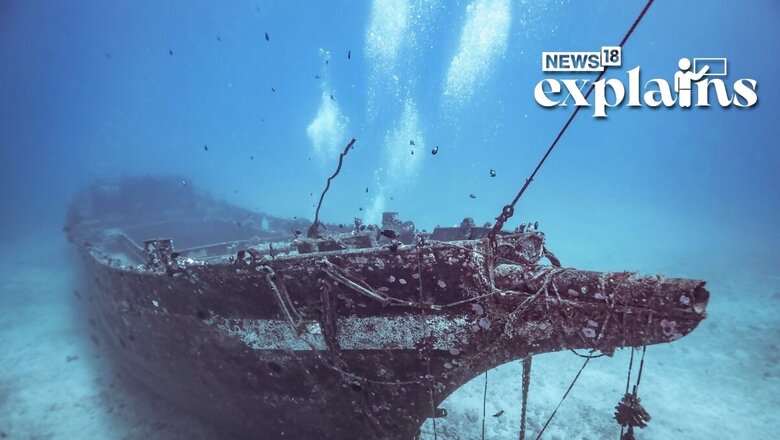
views
A CSIRO research has established the location of the MV Blythe Star shipwreck, which sank off the coast of Tasmania over 50 years ago. On October 13, 1973, while travelling from Hobart to King Island, the ship began to list to the starboard before taking on water and capsizing.
Ten crew members jumped onto an inflatable life raft and spent nine days at sea in increasing weather before reaching land. At least one crew member died at sea, as per a report by the Guardian.
The remaining nine attempted to walk away from their landing place at Deep Glen Bay on the Forestier Peninsula, and two other crew members died as a result of exhaustion and hypothermia. They were rescued almost two weeks later, on October 26, after a small number of survivors wandered out and reached a road, where they flagged down a passing driver. Despite extensive ocean searches, no trace of the vessel was located for decades.
However, researchers from the CSIRO and the University of Tasmania have discovered the MV Blythe Star wreckage, which is located around 10.5 kilometres west of Tasmania’s South West Cape.
Last month, the team was investigating a subsurface landslip when they made the find, utilising mapping data and video photos to determine it was the MV Blythe Star. The wreck was coated with algae and seaweed, and the stern was damaged and the wheelhouse was missing.
Amid the development, let’s take a look at some other shipwreck mysteries that are yet to be solved and have intrigued readers for years:
Mary Celeste
The story of the brigantine Mary Celeste has become part of nautical folklore, thanks in great part to a short story written by Dr Arthur Conan Doyle, the author and creator of Sherlock Holmes. On November 7, 1872, the Mary Celeste sailed from New York destined for Genoa with a cargo of alcohol. Dei Gratia, another brigantine on an Atlantic passage, saw her drifting somewhere between the Azores and Portugal on the afternoon of December 5, almost a month later.
Captain Morehouse of the Dei Gratia suspected Captain Briggs of the Mary Celeste of being a good sailor and became suspicious of the boats’ whereabouts. He dispatched a boarding party to the Mary Celeste, and his crew discovered a deserted ship that was still seaworthy. Captain Morehouse divided his crew and set sail for Gibraltar on the Mary Celeste. Captain Briggs, his wife, child, and the crew of seven have yet to be found. It will never be known whether Briggs abandoned ship due to terrible weather or if there is a more sinister motive for their absence, as per a report by BOAT International.
The boat’s alcohol load was also undamaged, as were the captain’s and crew’s personal possessions. None of the passengers were ever seen or heard from again.
The Carroll A. Deering
The Carroll A. Deering cargo ship and its ten-man crew arrived at Rio de Janeiro in 1920, despite the fact that its original skipper became ill, but something unexpected happened on the route back to Virginia. A lightship keeper in North Carolina stated that a crewman who didn’t appear to be an officer reported that the ship had lost her anchors while the rest of the crew was “milling about” suspiciously, according to a Reader’s Digest report.
The next day, another ship observed the Carroll A. Deering near the Outer Banks, which would have been an unusual track for a ship on its way to Norfolk, Virginia. A shipwreck was discovered the next day, but perilous conditions kept investigators away for four days. When they got on board, they found food put out as though they were getting ready for a meal, but the crew’s personal items and the lifeboats were gone.
The federal authorities pursued leads on pirates, mutinies, and other issues, but all were futile.
Sajo
In early 2016, the body of German sailor Manfred Fritz Bajorat was discovered slumped over the desk of his vessel Sajo. Fishermen discovered the bleak discovery as they boarded the drifting yacht off the coast of Barabo, Surigeo del Sur region, as per a report by BOAT International. Following a post-mortem examination, local police stated that there were no traces of foul play and that Bajorat died of natural causes, possibly a heart attack. His yacht was supposed to have been at sea for months before it was discovered, and the dry, salty conditions on board caused his body to mummify.
High Aim No. 6
The fishing boat High Aim No. 6 left Taiwan on Halloween in 2002, but it wasn’t the only ghost on board. Something was wrong when the Australian Navy discovered the ship in January 2003. The engine was running at full power, and the main petrol tank was completely empty, but the auxiliary fuel tanks were still full and undisturbed. Ten tonnes of bonito tuna were kept cold, but there was no personnel to be found.
It was destined to be one of the most enigmatic ghost ships of all time until one of its crew members was discovered. The Indonesian fisherman was apprehended and revealed that the crew had collaborated with pirates to kill the ship’s captain and senior engineer, but their motive remains unknown, as per the report by Reader’s Digest.
HMS Resolute
HMS Resolute was a British Royal Navy ship discovered abandoned and floating in the Canadian Arctic in 1854 off the coast of Baffin Island. She had been despatched to investigate the remains of another lost voyage, Sir John Franklin’s attempt to find the then-frozen Northwest Passage, but she met a same fate. The crew of the HMS Resolute had abandoned ship after becoming entangled in an ice floe, as per BOAT International.
Those who discovered the ghostly ship in 1855 were faced with an uncanny scene; the captain’s cabin remained intact, with a teapot, bible and glasses full of spirits on the desk. Captain Kellett, the ship’s commander, had a British flag draped over his chair. HMS Resolute was eventually rescued and decommissioned in 1879. Her timbers were used to build the Resolute desk, which has been used in the Oval Office by practically every American president since the nineteenth century. Captain Kellett, the ship’s commander, had a British flag draped over his chair. HMS Resolute was eventually rescued and decommissioned in 1879. Her timbers were used to build the Resolute desk, which has been used in the Oval Office by practically every American president since the nineteenth century.




















Comments
0 comment